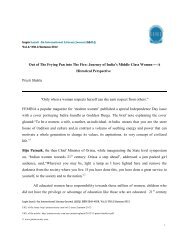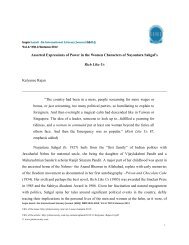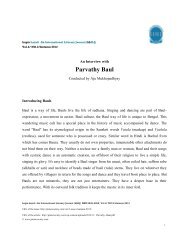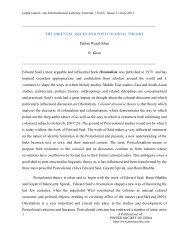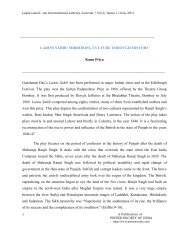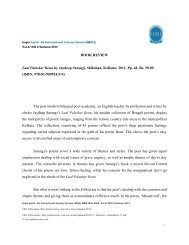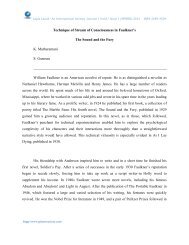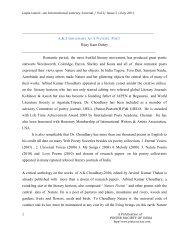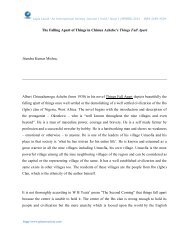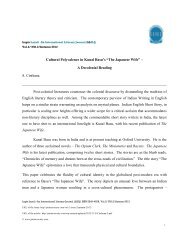Major Themes in Rohinton Mistry's Novels Nidhi Gupta - lapis lazuli
Major Themes in Rohinton Mistry's Novels Nidhi Gupta - lapis lazuli
Major Themes in Rohinton Mistry's Novels Nidhi Gupta - lapis lazuli
Create successful ePaper yourself
Turn your PDF publications into a flip-book with our unique Google optimized e-Paper software.
Lapis Lazuli –An International Literary Journal / Vol.II/ Issue I /SPRING 2012 ISSN 2249-4529<br />
down by their families, exhausted by the stra<strong>in</strong> of it‖. (13) Nariman‘s parents see education as<br />
the cause of sorrow: ―Modern ideas have filled Nari‘s head. He never learned to preserve that<br />
f<strong>in</strong>e balance between tradition and moderness‖. (15) This theme of coercion exercised by the<br />
family is repeated <strong>in</strong> a different context with Jal, Nariman‘s stepson.<br />
Nostalgia is a recurrent theme <strong>in</strong> Mistry‘s fiction. This nostalgia is generally for a past<br />
way of life, forever lost to the ma<strong>in</strong> characters. It is occasionally manifest <strong>in</strong> the idealization of<br />
religious rituals which are seen as a way to preserve the past and prevent the dis<strong>in</strong>tegration of the<br />
family and the community. It also takes the form of rem<strong>in</strong>isc<strong>in</strong>g about childhood which is seen<br />
as a more stable and reassur<strong>in</strong>g world than the present. These rem<strong>in</strong>iscences, presented <strong>in</strong> the<br />
stories of various characters <strong>in</strong> both the short stories and the novels, are l<strong>in</strong>ked to the changed<br />
circumstances of the Parsi community follow<strong>in</strong>g Independence. This politico-cultural nostalgia<br />
helps to create a sense of loss about the changed circumstances of the characters <strong>in</strong> both domestic<br />
and public spheres.<br />
All of Mistry‘s texts play with the boundaries of the private and the public. Most of<br />
Mistry‘s ma<strong>in</strong> protagonists, such as Gustad and Yezad, <strong>in</strong>habit the two realms simultaneously,<br />
while test<strong>in</strong>g the boundaries of both. The public world is the world of the ord<strong>in</strong>ary citizen,<br />
consist<strong>in</strong>g of friends, acqua<strong>in</strong>tances and the professional space of work where these adult<br />
relationships are forged. As the earlier we have <strong>in</strong>dicated, the themes of politics, history and<br />
community are <strong>in</strong>tegral to the life of Mistry‘s characters. The private world is the space of the<br />
home and the family, <strong>in</strong>habited mostly by women and children.<br />
Age is a central theme <strong>in</strong> Mistry‘s fiction and relationships between and across<br />
generations is a major concern whenever Mistry discusses the private realm of the family and the<br />
htpp//www.p<strong>in</strong>tersociety.com




